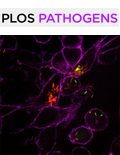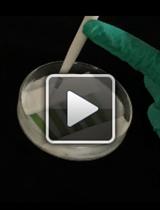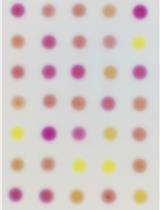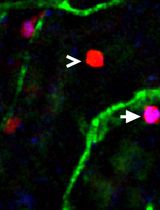- EN - English
- CN - 中文
Neutrophil Extracellular Trap Killing Assay of Candida albicans
白念珠菌中性粒细胞胞外诱杀试验
发布: 2020年08月20日第10卷第16期 DOI: 10.21769/BioProtoc.3716 浏览次数: 6151
评审: Kristin L. ShinglerEmmanuel Orta-ZavalzaSuresh Panthee
Abstract
Fungal pathogen Candida albicans is one of the top leading causes of overall healthcare-associated bloodstream infections worldwide. Neutrophil is the major effector cell to clear C. albicans infection. Our study showed that mouse neutrophils utilize two independent mechanisms to kill C. albicans: one is CR3 downstream NADPH oxidase-dependent mechanism that kills opsonized C. albicans; the other one is dectin-2-mediated NADPH oxidase-independent neutrophil extracellular trap (NET) that kills unopsonized C. albicans. Neutrophil killing of opsonized C. albicans requires phagocytosing the organism and production of reactive oxygen species production (ROS). Most existing protocols that assay for neutrophil killing of C. albicans requires a washing step after allowing neutrophils to phagocytose the organism. By definition, NET kills organisms extracellularly. Therefore, it is important to skip the washing step and add an optimal ratio of neutrophils and C. albicans to the wells. To demonstrate the effect of NET, it is necessary to compare killing ability of neutrophils treated with micrococcal nuclease (MNase), an enzyme that digests NET, to that treated with heat-inactivated MNase. MNase is also applied to release NET-bound fungal elements for counting. This protocol can be applied to assay NET killing of other biofilm-forming organisms.
Keywords: Neutrophil extracellular trap (中性粒细胞胞外诱捕)Background
Candida albicans is an opportunistic fungal pathogen that resides as a commensal on mucosal surface and the skin in most humans. Environmental changes in temperature, nutrition, or the presence of serum induces its transformation from yeast form to hyphae. Candida infection is one of the top leading causes of overall healthcare-associated bloodstream infections in medical centers as well as regional hospitals. Mortality among patients with invasive candidiasis is as high as 40% even after receiving antifungal therapy (Brown et al., 2012; Chen et al., 2014; Kullberg and Arendrup, 2015). Patients with neutropenia and neutrophil dysfunction are at high risk for invasive candidiasis, suggesting the importance of neutrophil anti-Candida functions in host defense (Antachopoulos et al., 2007; Horn et al., 2009; Lionakis and Netea, 2013). Our work showed that mouse neutrophils utilize two independent mechanisms, one NADPH oxidase-dependent and the other NADPH oxidase-independent, to kill C. albicans. NADPH oxidase-dependent killing of opsonized C. albicans requires phagocytosis mediated by CR3, and NADPH oxidase-independent killing of unopsonized C albicans is through NET formation mediated by dectin-2 (Wu et al., 2017 and 2019). MNase is an enzyme that digests NET. To demonstrate the effect of NET, it is necessary to compare the killing ability of neutrophils that is treated with MNase to that treated with heat-inactivated MNase. Difference between the two treatments denotes killing by NET and not by other factors (Wu et al., 2019). Neutrophils are phagocytic. Taking up microorganisms through receptors triggers robust ROS production that kills the engulfed organism. To assay for NADPH oxidase-dependent killing of opsonized C. albicans, one of the important steps is to wash off un-engulfed microorganisms after allowing time for phagocytosis to take place (Vonk et al., 2012; Wu et al., 2017). In contrast, since NET kills microorganisms extracellularly, it is critical not to wash off un-engulfed organisms to assay for NET-mediated killing of C. albicans. Moreover, instead of lysing neutrophils by ddH2O at high pH (pH 11.0) to release ingested microorganisms, NET-forming neutrophils and fungal hyphal elements are detached from the wells by mini cell scraper and DNA digesting enzyme MNase (Wu et al., 2017 and 2019). The method described here were published in 2019 (Wu et al., 2019) to observe killing of C. albicans by NET. This method can be adapted to quantify NET-mediated killing of other biofilm-forming organisms.
Materials and Reagents
- Pipette tips
- Mini cell scraper (Biotium, catalog number: 22003 )
- Flat-bottomed 96-well plates (Corning, catalog number: 3599 )
- 15 ml conical tube (Corning, catalog number: 430791 )
- 90 mm x 15 mm Petri dish (Alpha Plus, catalog number: 16001 )
- 1.5 ml microcentrifuge tube (Corning, catalog number: MCT-150-C )
- 3 ml syringe with 23-gauge needle (BD, catalog number: 302111 )
- Parafilm (Bemis, catalog number: PM996 )
- C. albicans SC5314 strain (ATCC MYA-2876)
- Female inbred mice in C57BL/6JNarl background, 6-12 weeks of age (National Laboratory Animal Center, RMRC11005)
- Percoll (GE Healthcare, catalog number: 17-0891-01 )
- 10x Dulbecco's Phosphate Buffered Saline (DPBS) (Biological Industries, catalog number: 02-023-1A )
- 10x Hank's Balanced Salt Solution (HBSS) (Biological Industries, catalog number: 02-015-5A )
- 0.4% Trypan blue (Sigma-Aldrich, catalog number: 93595 )
- 7.5% sodium bicarbonate (Biological Industries, catalog number: 03-040-1B )
- Yeast-peptone-dextrose (YPD) broth (Bioshop, catalog number: YPD002.500 )
- Agar A (BIO BASIC, catalog number: FB0010 )
- 2 x 106 U/ml Micrococcal nuclease (MNase) (NEB, catalog number: M0247S )
- Sterile double distilled H2O (ddH2O), adjusted to pH 11 by NaOH
- 1x Dulbecco's Phosphate Buffered Saline (DPBS) (see Recipes)
- 1x Hank’s Balanced Salt Solution (HBSS) (see Recipes)
- YPD agar plate (see Recipes)
- Red blood cell (RBC) lysis buffer (see Recipes)
- 100% Percoll (see Recipes)
- 55%, 62%, and 81% Percoll (see Recipes)
- Heat-inactivated micrococcal nuclease (MNase, see Recipes)
Equipment
- FinnpipetteTM F1 Variable Volume Pipettes (Thermo Scientific, catalog numbers: 4641050N , 4641080N , and 4641100N )
- Counting chamber Neubauer-improved (HAUSSER, catalog number: CB73811-01490 )
- Autoclave Machine (see Note 2)
- 37 °C, 5% CO2 incubator (see Note 2)
- 30 °C incubator for growing C. albicans yeasts (see Note 2)
- Table top general-purpose centrifuge with swinging bucket rotor (KUBOTA, Model 4000, Rotor Name: ST-720M and PT-89M)
- CellGard ES Energy Saver Class II Type A2 Biological Safety Cabinet (NuAire, model: NU-475-400 )
- Vortex-Genie 2 (Scientific Industries)
- Light Microscope (see Note 2)
- Surgical operating dissecting scissors (sharp/sharp) (see Note 2)
- Semken forceps (see Note 2)
- Euthanasia chamber that is used to administer CO2 for euthanasia (see Note 2)
Software
- Prism GraphPad Software (CA, USA)
Procedure
文章信息
版权信息
© 2020 The Authors; exclusive licensee Bio-protocol LLC.
如何引用
Wu, S. and Wu-Hsieh, B. A. (2020). Neutrophil Extracellular Trap Killing Assay of Candida albicans . Bio-protocol 10(16): e3716. DOI: 10.21769/BioProtoc.3716.
分类
免疫学 > 免疫细胞功能 > 嗜中性粒细胞
微生物学 > 抗微生物试验 > 杀伤试验
细胞生物学 > 基于细胞的分析方法 > 真菌感染
您对这篇实验方法有问题吗?
在此处发布您的问题,我们将邀请本文作者来回答。同时,我们会将您的问题发布到Bio-protocol Exchange,以便寻求社区成员的帮助。
Share
Bluesky
X
Copy link














